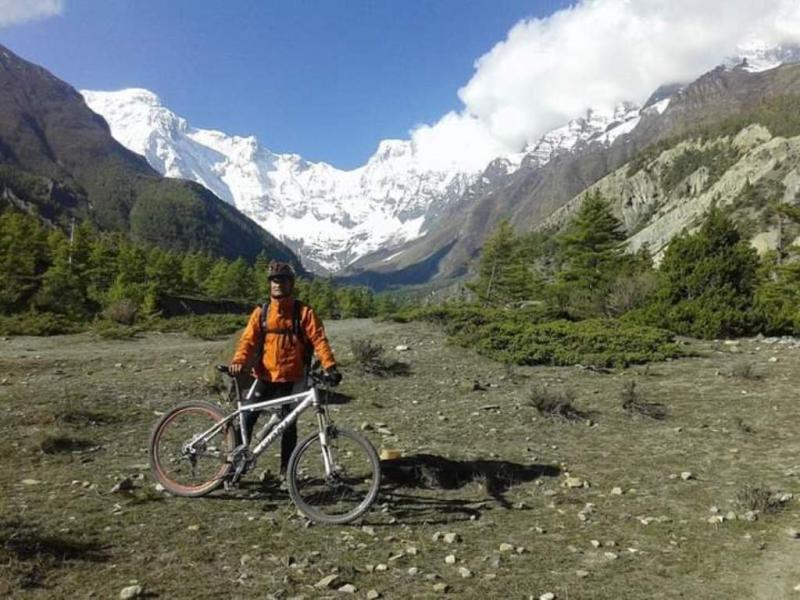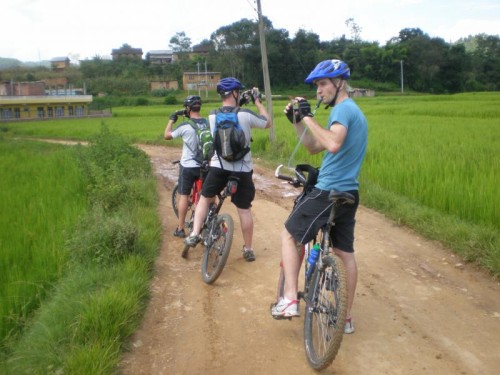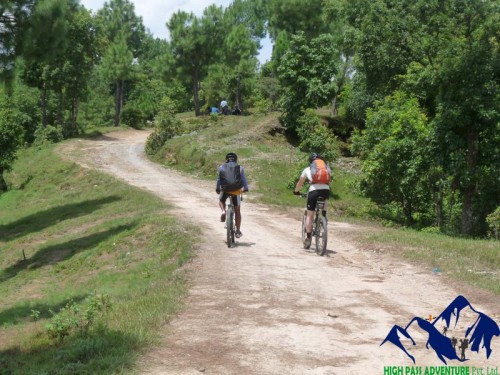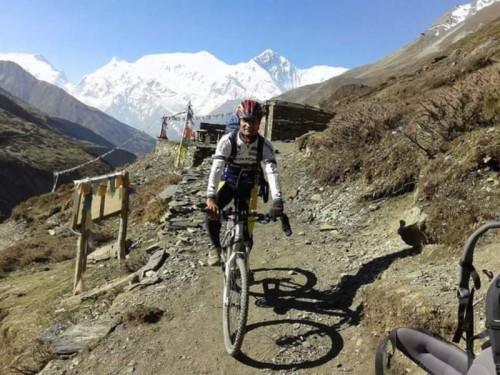Best time for Annapurna Circuit Mountain Biking
The best time for Annapurna Circuit Mountain Biking is during autumn (September to December) and spring (March to May). During these seasons, the Annapurna Circuit offers ideal weather conditions—sunny and warm, but not too hot, with minimal rain or snow. Compared to winter and summer, these months are perfect for outdoor activities like mountain biking and trekking due to stable weather and clear visibility.
Winter (January and February) and summer (June to August) are not recommended for Annapurna Circuit Mountain Biking. Winter temperatures can be extremely cold, and the Thorong La Pass is sometimes blocked due to heavy snowfall. In summer, the trail can become muddy and slippery due to the monsoon, with an increased risk of landslides and poor visibility for photography.
Therefore, you should choose the season that best fits your vacation schedule. Regardless of the time of year, we highly advise all bikers to come well-equipped and properly geared for the journey. Annapurna Circuit Mountain Biking offers stunning scenery and diverse landscapes in every season.
How difficult is Annapurna Circuit Mountain Biking?
The difficulty level of Annapurna Circuit Mountain Biking is moderate to challenging, yet it is a highly rewarding adventure. It demands a good level of physical fitness, mountain biking experience, mental flexibility, and determination. The route covers a wide range of terrain—from smooth dirt roads and single tracks to rocky, steep, and high-altitude sections, with some paved (blacktop) parts after Muktinath.
Riders should be fit enough to bike 5 to 7 hours a day over the course of 9 to 10 days. One of the most demanding parts of the ride is crossing the Thorong La Pass at 5,416 meters (17,769 ft), which requires proper acclimatization due to the thin air and lower oxygen levels. Cyclists must be prepared to push or carry their bikes in certain sections, especially near the Thorong La Pass, where the ascent and descent are too steep and rugged to ride. One of the most fulfilling moments of the trip is the sense of accomplishment upon reaching the top of Thorong La Pass—a truly unforgettable achievement.
Despite the challenges, the Annapurna Circuit offers incredible rewards—from awe-inspiring mountain views and cultural encounters with local communities to a diverse landscape that transition from lush green valleys to high-altitude alpine deserts. While the ride is not suitable for complete beginners, it is an once-in-a-lifetime experience for confident riders with prior off-road or high-altitude biking experience. Proper preparation is essential, including physical training, altitude awareness, having an experienced guide, and carrying the right gear. With the right mindset and preparation, this adventure can be completed safely and enjoyably.
Altitude Sickness and preventions during Annapurna Circuit Cycling
Altitude sickness, also known as Acute Mountain Sickness (AMS), is a common concern during Annapurna Circuit Cycling due to the high elevations, especially when crossing Thorong La Pass at 5,416 meters. Symptoms may include headache, nausea, dizziness, fatigue, and shortness of breath, and can affect even the most physically fit riders. The rapid gain in elevation without proper acclimatization is the primary cause. Since the route ascends from lowland areas to high-altitude terrain over a short period, cyclists must pay close attention to their body's signals and take altitude sickness seriously.
To prevent altitude sickness during the ride, gradual acclimatization is important. Our itinerary is flexible with rest and acclimatization days, especially before attempting passe. Stay well-hydrated, avoid alcohol and smoking, eat nutritious food, and ride at a steady pace without overexertion. If symptoms occur, it's important to rest, descend if necessary, and seek medical attention if conditions worsen. Taking preventive medications like acetazolamide (Diamox) after consulting a doctor can also help. Most importantly, riding with an experienced guide familiar with high-altitude conditions to enhance safety and ensure the proper response to any altitude-related issues.
Required Permits and Cost for Annapurna Circuit Mountain Biking
For the Annapurna Circuit Mountain Biking trip, two permits are required: the Annapurna Conservation Area Permit (ACAP) and the Trekkers' Information Management System (TIMS) Card. The ACAP helps protect the environment and supports local development efforts in the Annapurna region, while the TIMS card is used to track trekkers and ensure their safety and security during the journey.
These permits can be obtained through registered trekking agencies or directly from the Nepal Tourism Board offices in Kathmandu or Pokhara. It is highly recommended to secure these permits in advance to avoid delays and begin your trip on time. You or your guide must carry the permits throughout the journey and present them at various checkpoints along the Annapurna Circuit. If you are found cycling without valid permits, you may be required to purchase them on the spot at double the cost (as a penalty), or you may be asked to turn back.
Permit Costs:
TIMS (Trekkers’ Information Management System) Card:
- US$ 20 per person / per trek
Annapurna Conservation Area Project (ACAP) Permit:
- US$ 30 per person / per trek for all foreign trekkers
- US$ 10 per person / per trek for SAARC national
Food and Accommodation in Annapurna Circuit Mountain Biking
During the Annapurna Circuit Mountain Biking trip, food and accommodation are provided by the teahouses and lodges along the route. These Teahouses and Lodges offer basic but comfortable lodging with twin-sharing rooms and shared or private bathrooms depending on the location and altitude. While lower-altitude areas may offer more modern amenities, facilities become more basic as you ascend. Most teahouses are cozy and provide a welcoming environment to rest after a long day of biking, with opportunities to connect with fellow travelers and enjoy stunning mountain views.
Regarding food, every teahouse and lodge has a menu, and the food items are generally the same at each location. They serve a variety of freshly prepared meals, ranging from traditional Nepali dishes like dal bhat (rice, lentil soup, and vegetables) to international options such as pasta, noodles, pancakes, and soups. Breakfast, lunch, and dinner are usually available at the same teahouse where you stay or at designated lunch stops along the way. Although the cooks are trained, the taste of the food may be slightly different from what you're used to in the West. While the food options remain consistent, prices tend to increase with altitude due to transportation challenges.
Staying hydrated and eating well is essential for maintaining energy and aiding acclimatization. Riders are encouraged to eat balanced meals, drink plenty of water, and avoid alcoholic beverages, especially at higher elevations and throughout the journey.
Charging and Wi-Fi Facilities for Annapurna Circuit Mountain Biking
During the Annapurna Circuit Mountain Biking trip, charging and Wi-Fi facilities are available at most teahouses and lodges, especially in the lower-altitude villages. However, these services are often not included in the room price and usually come with an additional cost. Charging is typically done through solar power in places like Yak Kharka and Thorong Phedi, where electricity sources are limited. It is highly recommended to carry a power bank or solar charger to keep your devices powered, especially in higher-altitude areas where charging facilities can be scarce or unreliable.
Wi-Fi is accessible in many teahouses, particularly in popular villages, but the signal strength and speed can be inconsistent, especially as you gain altitude. In higher areas like yak kharka or near Thorong Phedi and Pass, Wi-Fi may be weak, very slow, or completely unavailable. Some teahouses offer paid satellite Wi-Fi services, which can help you stay connected, though they may not support heavy data use. For better connectivity entire journey and safety, we advice to all trekkers purchase a local SIM card (such as Ncell or NTC) with a data package before starting the trip. However, mobile network coverage is also limited in remote high-altitude sections of the route.
Getting There: Nepal
Between China's Tibet Autonomous Region and India, Nepal is a landlocked Himalayan nation. It has eight of the top ten mountains in the world, including Mount Everest. There are numerous points from China and India where one can enter Nepal by land. Tourist visas for Nepal are available on arrival at all Indian and Chinese borders if you are traveling there by land. There are numerous foreign airlines providing nonstop connecting flights to Nepal if you're arriving by air. Nepal Airlines, Turkish Air, Thai Airways, Gulf Air, Qatar Air, Jet Airways, Air India, Biman Bangladesh, Lufthansa, Oman Air, Travel Dubai, Air Arabia, and Air China are a few of the well-known airlines that fly to Nepal. From China or India, one can also go overland. Please check your flight and get in touch with us before arriving in Nepal. At the airport in Nepal, you can easily obtain an on arrival visa.
Visa and passport information
Except for Indian passport holders, all foreign visitors to Nepal need a visa; however, you must have a passport with a six-month validity date in order to apply for a tourist visa. At the Tribhuvan International Airport and the Chinese-Indian border in Tibet, visas are available on arrival. To apply for a visa to enter Nepal, you must have a color photograph in PP size. Please click this link for more details about Visa Information.
Money exchange rate and prices
If you're seeking for the best foreign exchange rates and locations in Nepal, you may easily exchange the majority of your foreign currency at a local bank or authorized money exchange facility in a well-known tourist destination. The Nepal Rastra Bank controls all exchange rates (Center Bank of Nepal). You can exchange small amounts of money at the hotel if you want to. Because our banks will not take dirty or old notes, kindly bring clean and fresh notes.
In order to avoid the time-consuming processes associated with cards and traveler's checks, Nepalese people typically prefer cash in hotels, restaurants, shopping malls, and other locations. You can use an ATM to get cash (in Nepali Rupees) if you have a credit or debit card. In the main tourist city, there are a number of ATM counters with 24-hour service. If you use a card, the maximum withdrawal amount is between 30,000 and 35,000 rupees at once, plus a processing fee of 500 rupees.
You must convert your money in Kathmandu or Pokhara before the hike because the majority of trekking routes do not offer a facility for international currency exchange. Additionally, inquire about the amount of money required for a Himalayan trek from your trekking operator or guide.
Safety and security
When traveling in Nepal, safety and security are crucial issues to consider both on the way to in and out. We are here for you at all times, and we promise to provide the greatest service to all of our cherished clients. Our guides have extensive training in the field of trekking and broad understanding of first aid items. Because it rises more than 4000 m above sea level, it is essential for hiking in Nepal. Because health is crucial, if a trekker becomes ill from the high altitude, our knowledgeable guide discusses the necessary medications and decides to continue the trek while organizing the emergency rescue.
You must be cautious when hiking trails pass one other because they are not wide enough to do so. During the busiest trekking season, there are lots of porters, yaks, mules, and Jokpe along the trail. You must stay on the safe side if you encounter them on a bridge or in a confined space because otherwise they may force you over the edge.
Safe drinking water
For a healthy body while traveling and staying hydrated, clean water is essential. It will be the most effective method of completing the Himalayan journey. If not, getting sick and having diarrhea is simple. Almost everywhere during the Nepalese tea house trip, but not during the camping trek, sells bottled water. Unfortunately, bottled water is very pricey.
Please bring good water bottles (for boiling water) and water purification tablets or water filter bottles since plastic bottles are detrimental for the environment. Reusable water bottles are a good idea because they help keep the mountain clean. If you are concerned about finding a typical water tap to fill up your bottles in the trekking region of Nepal, they are very simple to locate. It can be found in rivers, streams, and lodges.
Travel insurance and insurance policy
Nepal hiking tours: The difficulty levels of the Himalayas range from easy to tough. As a result of the Himalayan climate changing, there is a risk of high altitude and potential mishap.
Trekking in the Nepalese Himalayas demands practical trekking abilities at high altitudes (above 4,000 meters), so travel insurance is essential. If an accident occurs during a trip and requires medical attention or evacuation, the cost of returning to a city and receiving treatment may be significant. Therefore, you must ensure that your insurance covers the price of an air ambulance, medical care, and any risks associated with travel, such as delayed flights and lost, stolen, damaged, or missing baggage. Your complete itinerary while visiting Nepal should be covered by your insurance policy. Make sure your insurance policy covers hikes higher than 5,500 meters. If not, you will be responsible for all unforeseen costs associated with your trek through Nepal.
All trekkers must send a copy of their certificate from their comprehensive travel insurance policy to High Pass Adventure as part of the booking process for trekking and climbing in Nepal.
High altitude sickness information
Mountain sickness is another name for high altitude sickness. You must be aware of high altitude sickness symptoms since they arise rapidly if you hike or ascend to a higher elevation. Here are some details if you're curious as to why it occurs. The air pressure is the main cause of altitude sickness. Your body needs time to adapt to the shift in air pressure when you travel to higher elevations since the air pressure decreases and there is less oxygen present. According to doctors, If you are at sea level, it begins at 8,000 feet (2400 meters).
1) Types
There are three types of altitude sickness:
Acute Mountain Sickness (AMS): it is very common and symptoms feel like a tiredness, dizzy, headache, thirsty, muscle aches, nausea
High Altitude Pulmonary Edema (HAPE): it is effect in the lungs, which can be very dangerous and hard to do life threatening
High Altitude Cerebral Edema (HACE): it is effective in the brain and most difficult to treat and you need to go to hospital attention the right way.
2) Cause
Following are the causes of high altitude sickness:
Generally living near sea level and travel to a high elevation
Had the sickness before
Climbing quickly
Not being acclimatized to the altitude
Drinking alcohol when you ascend
Medical problems of heart, nervous or lungs
3) Symptoms
These symptoms will appear depending on your speed to climb and how hard you push. Symptoms range from normal to serious. They can affect the nervous system, lungs, muscles, and heart.
Here are symptoms of High Altitude Sickness:
Difficulty sleeping
Dizziness
Fatigue
Headache
Loss of appetite
Nausea or vomiting
Rapid Pulse (Heart Rate)
Short breath with action
Blue color of skin or gray soft skin
Chest tightness or blocking
Confusion
Dry cough or coughing with blood
Cannot walk in a straight line
4) Prevention
Important keys to preventing of High Altitude Sickness are:
Climb the mountain gradually.
Stop every 2,000 feet (600 meters) of climb above 8,000 feet (2,400 meters) and one or two nights sleep there.
Sleep at a lower altitude when possible.
Make sure that you have the ability to quickly descend if needed.
Learn how to recognize early symptoms of mountain sickness.
If you plan on climbing quickly, or climbing to a high altitude, ask your provider about medicines that may help.
If you are at risk for a low red blood cell count (anemia), ask your provider if your planned trip is safe. Also ask if an iron supplement is right for you. Anemia lowers the amount of oxygen in your blood. This makes you more likely to have mountain sickness.
5) While climbing, you should follow these rules:
Drink plenty of water
Climb slowly.
Take it easy
Do not drink alcohol.
Eat regular meals that are high in carbohydrates.
Sleep lower elevation
Take a medication (diomax) according to doctor









Patrice
Austria
Annapurna Circuit Cycling Tour - Memorable Experience
16th July, 2023
We were five people in a group for the Annapurna Circuit Mountain Bike adventure in October 2018. We chose High Pass Adventure Trekking as our biking company for our trip. The mountain biking trip is guided by Sundar who has been many times. So he made the trip enjoyable and memorable in our life. So This was an amazing trip! The itinerary is well designed with every day 4-5 hours of ride, and an acclimatized day in Manang. Roads are surprisingly challenging but the acclimatized day made it easy to push over the Thorong La Pass. If you are thinking about mountain biking in Nepal, go with High Pass Adventure Trekking and use a guide sundar you will get a lifetime experience you will never forget!!!! I highly recommend to all who are planning a annapurna circuit cycling tour that you need previous biking experience to do the Annapurna Circuit Cycling Tour.